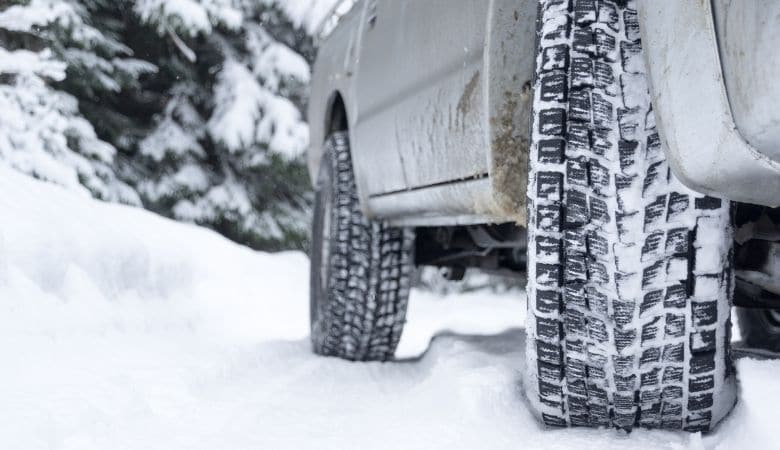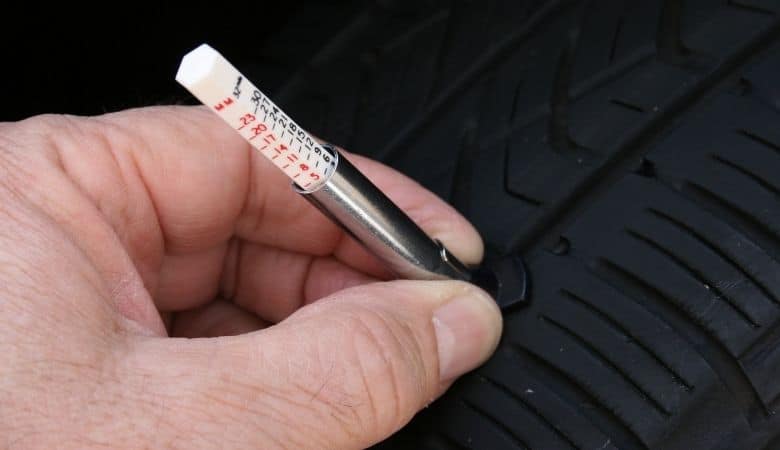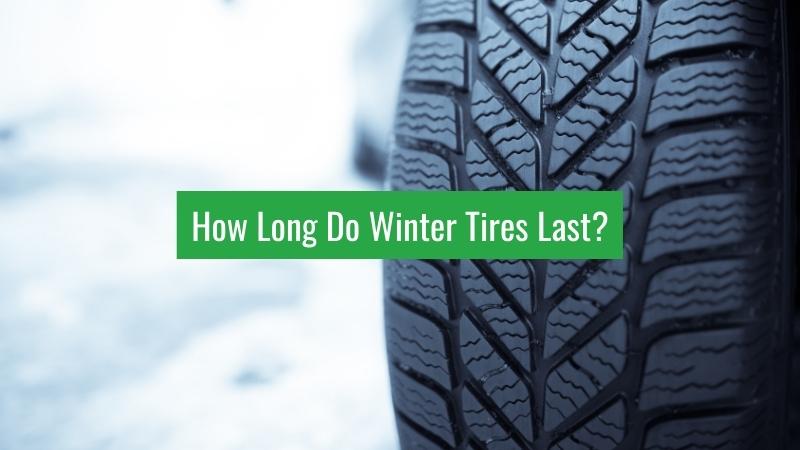When it comes to winter tires, one question that might be on your mind is how long they last and when it’s time to replace them.
Winter tires are designed to provide optimal performance in cold, icy, and snowy conditions, which is essential for your safety on the road.
However, like all tires, they wear down over time, and knowing when to replace them is vital for maintaining their effectiveness and your safety.
On average, winter tires can last up to four to five seasons with proper maintenance and normal usage, accounting for about 12,000 to 15,000 miles per year during a four-month winter period. The actual lifespan of your winter tires, though, depends on factors such as the quality of the tire, your driving habits, and how well you care for them.
To know when it’s time to replace your winter tires, it’s essential to learn how to check their condition and watch for signs of excessive wear.
Understanding Winter Tires

Before diving into how long winter tires last, it’s important to understand their unique characteristics and why they’re essential for colder weather conditions.
Tire Composition
Winter tires are made of special rubber compounds that remain flexible in low temperatures, offering improved traction on ice and snow-covered roads. This flexibility enhances your driving experience by providing better grip and shorter braking distances.
A common and important measure of a tire’s grip in winter driving conditions is the tread depth; winter tires should generally have a tread depth of 5/32 inches or more to perform optimally in harsh conditions.
Design
In addition to their specialized rubber composition, winter tires also have unique design features tailored for cold weather. These include:
- Sipes: Small cuts in the tread that improve grip by providing more biting edges that can help in reducing the likelihood of slipping on icy roads.
- Deep grooves: Channels that allow snow, slush, and water to be evacuated more efficiently from the tire’s contact patch, which enhances traction and decreases the risk of hydroplaning.
- Aggressive tread pattern: Designed to provide better grip on both snow and ice, as well as enhancing traction during cornering and accelerating.
Maintaining proper tire pressure is also essential for optimal performance during winter. Cold temperatures can cause the air inside the tires to contract, leading to a drop in tire pressure.
Make it a habit to regularly check and adjust your tire pressure to ensure a safe and comfortable ride throughout the winter season.
How Long Do Winter Tires Generally Last?
Winter tires, if maintained properly and used only during appropriate winter months, can last for about four to five seasons, with some manufacturers even claiming up to six seasons. This estimate assumes an average of 12,000 to 15,000 miles per year on a four-month drive on cold, icy, and snowy road conditions.
However, the lifespan of winter tires depends on various factors, such as the type of tire, driving habits, and road conditions.
How Long Do Studded Winter Tires Generally Last?
Studded winter tires are designed to provide extra traction on icy roads. The lifespan of studded winter tires is similar to that of studless winter tires, lasting around four to five seasons with proper maintenance and usage.
It is important to note that studded winter tires may wear down faster if used on dry or wet roads, as the studs can cause damage to the tire’s rubber and the road itself. For this reason, it is crucial to switch to regular tires when winter conditions are not present.
How Long Do Studless Winter Tires Generally Last?
Studless winter tires are made from a special rubber compound designed to remain flexible and provide better traction in cold temperatures. With proper care and usage, studless winter tires can also last for around four to five seasons.
It is essential to keep in mind that using these tires in warmer conditions can lead to faster wear, as the soft rubber is not designed for temperatures above 45°F (7°C).
To extend the lifespan of your winter tires, be sure to regularly inspect their tread depth, as this is an important indicator of their performance and safety. Manufacturers typically recommend replacing winter tires when the tread depth reaches 4/32 inches or after six years of usage.
Factors Affecting Winter Tire Lifespan
Several factors can influence how long your winter tires last. To make informed decisions on when to replace your winter tires, consider the following factors:
Driving Conditions
Winter tires are designed to perform in cold, icy, and snowy road conditions. The type of roads you drive on and your driving style can both affect the lifespan of your tires. For example, if you drive on rough roads or frequently encounter sharp turns and sudden braking, your tires will wear more quickly.
Tire Maintenance
Proper tire maintenance plays a significant role in extending the life of your winter tires. It is essential to regularly check and maintain the correct tire pressure, as underinflated or overinflated tires can cause uneven wear and shorten their lifespan.
Rotating your tires as recommended by the manufacturer can also help distribute wear more evenly, ensuring a longer life for your tires.
On average, winter tires can last up to four to five seasons or 12,000 to 15,000 miles, as suggested by Tire Hungry, but proper maintenance, including tire pressure monitoring and rotation, is vital for maximizing this lifespan.
Storage Practices
Proper storage of your winter tires during the off-season can help prolong their life. When not in use, store your tires in a cool, dry place away from direct sunlight and heat sources to avoid drying and cracking of the rubber compound.
Storing them in airtight plastic bags can also help protect them from ozone damage and slow down the aging process.
In conclusion, various factors affect the lifespan of winter tires, including driving conditions, tire maintenance, and storage practices. By paying attention to these factors and ensuring proper care, you can help prolong the life of your winter tires.
Indicators It’s Time to Replace Your Winter Tires

Tread Depth
To ensure the best traction and road grip during winter conditions, regularly check the tread depth of your winter tires.
One simple method to do this is with the penny test. Insert a penny into the tread with Lincoln’s head upside down. If the top of his head disappears in the tread, your tires still have adequate depth. If you see any part of his head, it’s time for a tire replacement.
Tires with worn tread might not provide the necessary grip for icy or snowy roads, compromising your vehicle’s safety.
Tire Age
Even if the tread on your winter tires appears to be in good condition, keep in mind that tires have a limited lifespan. Most tires shouldn’t be used for more than 10 years due to degradation of the rubber compounds.
Check the manufacturing date on the sidewall of your tires, which can be found as a four-digit number (e.g., 3517 means the 35th week of 2017). This can help you determine if your winter tires are nearing the end of their useful life.
Visual Inspection
Regularly inspect your winter tires for visible signs of wear or damage. Look for cracks, bulges, or uneven wear patterns on the tire’s surface.
If you notice any of these issues, it’s a good indicator that your winter tires may need replacement. Don’t neglect these signs, as damaged tires can lead to a blowout or loss of control on the road.
Performance Issues
If you’ve noticed a decline in your vehicle’s traction or handling in winter weather, it might be due to worn winter tires.
Some common symptoms include longer stopping distances, difficulty accelerating, or sliding on ice or snow. If you’ve experienced any of these issues, it’s a good time to investigate whether your winter tires need replacing.
Tips for Extending Winter Tire Life
Increasing the longevity of your winter tires will save you money and keep you safe on the road. By following the recommendations below, you can help your tires last longer.
Proper Tire Rotation
Rotating your tires regularly is key to even wear and extended life. It’s recommended to rotate your winter tires every 3,000 to 6,000 miles. This will help distribute the wear evenly across all four tires, ultimately leading to a longer lifespan for each tire.
During rotation, ensure that the tires are mounted correctly, and the lug nuts are torqued to the manufacturer’s specifications.
Proper rotation techniques may vary depending on your vehicle’s drivetrain, so consult your owner’s manual to determine the best rotation pattern for your specific vehicle.
Correct Tire Pressure
Maintaining the correct tire pressure is critical for tire performance and lifespan. Consumer Reports suggests keeping an eye on your tire pressure and adjusting it as needed to meet your vehicle manufacturer’s recommendations.
You can find the recommended tire pressure in your owner’s manual or on the tire information placard, typically located on the driver’s door jamb.
Remember that cold weather can cause tire pressure to drop, so it’s essential to check the pressure frequently during the winter season.
Off-Season Storage
Proper off-season storage can greatly affect the life of your winter tires. To ensure they maintain their performance, follow these steps:
- Thoroughly clean your tires – Remove any dirt, debris or brake dust to prevent any damage during storage.
- Store tires in a cool, dry place – High humidity and heat can cause the rubber to deteriorate, so keep your tires away from direct sunlight and high temperatures. A climate-controlled or insulated space is best.
- Stack or hang the tires – Do not store your tires on their sidewalls. Stack them on top of one another or hang them vertically to prevent any possible distortion.
- Keep them protected – Use specially designed tire totes or bags to protect your tires from dust, moisture, and unintentional damage.
By following these recommendations and treating your winter tires with care, you can expect a longer life and better performance from them throughout the winter season.
Conclusion
Winter tires generally have a lifespan of up to four to five seasons, and they can last even longer with proper maintenance and care. However, your tires’ longevity will depend on your personal driving pattern, road conditions, and overall tire care.
Here are a few essential tips to help you maximize the life of your winter tires and identify when it’s time for a replacement:
- Monitor tire tread depth regularly. Proper tread depth is crucial for maximum traction on icy and snowy roads.
- Inspect your tires for any signs of damage, such as cuts or cracks, and have them checked by a professional if you’re unsure about their condition.
- Keep your tires properly inflated, as this will help them perform optimally and last longer.
- Rotate your winter tires regularly to ensure even wear and increase their lifespan.
- Store your winter tires in a cool, dry place when not in use, and protect them from direct sunlight to prevent aging and damage.
By following these guidelines, you’ll not only extend the usability of your winter tires, but also ensure your safety on the road during those challenging winter months.
So, remember to check your tires regularly and drive with confidence, knowing that they’re well-maintained and ready for any winter road conditions.
Hi, my name is Niklas, the head content creator & CEO of Whirling Wheelz. I am very interested in vehicles of all kinds, mainly cars. I have a car mechanics degree from high school and a big hobby of mine is to follow the WRC (World Rally Championship) both online and through travel.


